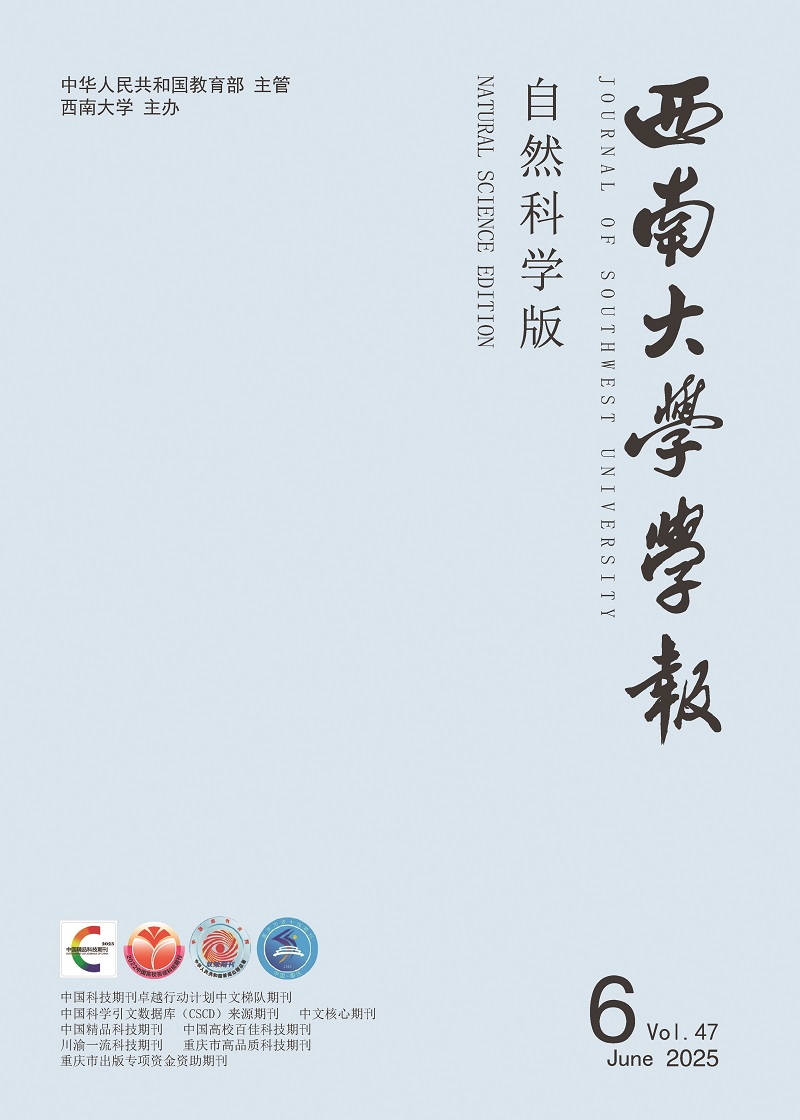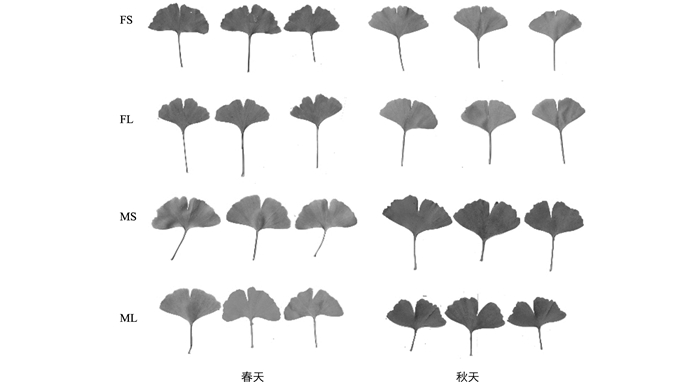-
银杏(Ginkgo biloba L.),雌雄异株,原产我国天目山地区,是著名孑遗植物,被誉为活化石[1-2],可观叶、观果、观树形,具有良好的景观价值和生态价值[3-4];银杏叶含有多种黄酮类物质[5],在心脑血管类疾病治疗[6]、大脑及中枢神经类疾病如阿尔茨海默病及帕金森病的治疗[7]、抗肿瘤[8-9]等方面具有很高的医药研究价值.由于银杏外种皮腐烂后有恶臭,因此不结果的雄株银杏在园林应用上优于雌株[10];而农业生产上希望栽植雌株银杏以收获经济价值高的白果;而在杂交育种时,依据育种目的不同,有时只需要保留单一性别亲本.然而,银杏雌雄株要等开花后才能鉴别,需要25年左右[11].因此研究银杏非花果期性别鉴别具有重要的理论意义和实用价值.银杏性别鉴定在利用同工酶[12]、染色体核型[13]、分子标记[14-15]等分子技术上取得了一定的进展,但是这些技术复杂、耗时、不适用于生产实践;要找到生产上可操作性强的方法,还是应从银杏的表观形态学特征着手进行鉴别[16].
本研究对银杏非花果期的花芽发育、叶片形态特征、叶绿素质量比、气孔密度进行了对比分析,发现利用银杏长枝叶片的叶色和短枝叶片的叶面积、气孔密度来判断植株雌雄的方法,即春季雌株较雄株浓绿,秋季雄株较雌株晚黄;雄株叶片面积大于雌株,雌株叶气孔密度高于雄株;探索成年银杏的一些表观特征与雌雄性别间的可能偶联关系,为银杏非花果期性别鉴定提供有价值的理论依据.
HTML
-
2015年4月,依据银杏开花时雄株上有小孢子叶球(柔荑花序状)、雌株上有大孢子叶球(Y字形)的特征,在重庆市北碚区西南大学校园内(采样地平均海拔243 m,处亚热带季风性气候带,常规水肥管理)性别分化成熟的成年银杏进行性别调查.选取相似生境、树龄30年以上(根据西南大学校史记载和树干的胸径粗略判断)、性别确定的8株成年银杏(品种为:佛指‘Fozhi’)作为试验对象(表 1).
-
2014年11月至2015年4月,每月15日摘取银杏雌雄株花芽进行形态观察、花芽解剖、照相记录和对比分析.
-
叶片采集于2015年4月和10月,对8株试验银杏植株的整株色泽裸眼观察比较、照相记录,再用高枝剪对试验银杏进行采样.取样枝条离地约6 m,东南西北4个方向各取10个短枝(即生殖枝)和长枝(即营养枝),短、长枝条上随机选取50片无病虫害的成熟健康叶作为试验材料.
叶片扫描:将采集的叶片分组在Canon LiDE 110 Manual扫描仪上排列整齐,在叶片旁边摆放一个10 cm标尺,等比例扫描.
叶片形态数据采集:银杏叶由扇形叶片和叶柄组成,规定扇形叶片的叶脉方向为叶长,叶脉方向垂直为叶宽,叶形指数为叶长与叶宽的比值.使用Motic Images Advanced 3.2软件测量所采集叶片图像的叶长、叶宽、叶脉、叶基夹角、叶面积以及叶形指数等表观特征.
-
叶色比较:2015年4月、10月,在雌、雄株的东南西北4个方向各取10个短枝和长枝,各短、长枝条上随机选取50片无病虫害的成熟健康叶作为试验材料,使用Canon LiDE 110 Manual扫描仪采集图片,叶片颜色与电子潘通色卡(http://www.colorsz.com)比对,用对应的数值代码定性叶色深浅.
叶绿素质量比的测定:参照浸提法[17]提取银杏叶片叶绿素,使用UV-1000紫外分光光度计测定叶绿素质量比.
-
气孔密度测定于2015年4月和10月,在雌、雄株的东南西北4个方向各取10个短枝和长枝,各短、长枝条上随机选取无病虫害的成熟健康叶作为试验材料,用规格为∅0.5 cm打孔器在银杏叶片中部打孔取样,所取材料放入25 mL烧杯中,加Jeffrey离析液(V(铬酸):V(硝酸)=1:1) 将叶样完全浸泡,于50 ℃水浴锅中恒温离析1 h,取出材料,蒸馏水漂洗2~3次后保留在蒸馏水中,在水中剥离下表皮.取下表皮进行临时装片,以水为浮载剂,在Motic数码显微系统中观察、照相,每株银杏短、长枝各选取8份标本作为重复,每份标本观察5个视野,照相保存[18],然后用Motic Images Advanced 3.2软件统计单位面积内气孔数,计算气孔密度.
-
用Microsoft Office Excel 2007和spss19.0对采集的数据进行数据统计和分析.
1.1. 供试材料
1.2. 试验方法
1.2.1. 银杏花芽形态解剖与观察
1.2.2. 银杏雌雄株叶片形态数据采集
1.2.3. 银杏叶片叶色比较及叶绿素质量比测定
1.2.4. 银杏叶片气孔密度测定
1.2.5. 数据处理
-
调查发现,落叶期成年银杏雌雄株花芽外部形态存在稳定性差异(图 1).雌株花芽尖锐,呈圆锥形;雄株花芽圆润饱满,呈半球形;雌雄花芽形态上的这种显著差异可作为10月-3月花芽期成年银杏性别鉴定的可靠依据(图 1-1).
银杏雌株花芽包含3~6个大孢子叶球,大孢子叶球由2个大孢子叶发育而成,大孢子叶球顶端发育出“Y”型对生胚珠,一般其中一个胚珠发育成果实,另一个为其提供营养(图 1中2-7).
小孢子叶球由雄花芽发育而成,其蕾期圆润饱满,开花后发育成柔荑花序形态.小孢子叶顶端发育出椭圆形花粉囊,一个雄花芽多包含3个雄花序,偶见4~5个雄花序存在(图 1中8-12).
银杏在10月初时花芽开始明显分化,至4月上旬开花(图 1).银杏雌雄花芽发育进程接近,不仅外观形态有差异,解剖结构的差异也十分显著.因此,花芽的解剖构造可进一步作为非花果期的冬、春季节快速鉴别成年银杏性别的可靠依据.
-
分别就4株雌性银杏单株间(F1,F2,F3,F4)、4株雄性银杏单株间(M1,M2,M3,M4) 短枝和长枝上叶片各项形态特征进行统计,结果表明,同一性别、同类枝条上的银杏叶片其叶长、叶宽、叶柄、叶基夹角、叶面积和叶形指数等叶片形态特征参数具有良好的稳定性;同时也观察到,同一性别银杏的短枝和长枝上的叶片,其形态特征之间的差异具有统计学意义(表 2).因此,本研究在分析雌、雄性银杏非花果期叶片的形态特征时,将不同性别的长枝叶、短枝叶分别进行统计分析,以获得具有普遍应用价值的结论.
-
从表 2得知,银杏雌株短、长枝上的叶长、叶宽、叶基夹角、叶面积均分别显著小于银杏雄株短、长枝叶片的对应参数,仅叶柄显著大于雄株叶柄.叶形指数差异反映植物叶片形状的变化,叶形指数越小,叶片越扁宽[19].银杏雄株短、长枝叶片的叶形指数都分别大于雌株短、长枝条上叶片的叶形指数(表 2).由于银杏叶片发育成熟后的形态稳定,因此叶片的叶长、叶宽、叶基夹角、叶面积以及叶形指数差异都可以作为银杏性别鉴定的重要依据.
从表 2可知,同一性别银杏的短、长枝叶片之间的形态特征也存在差异,短枝叶宽、叶柄、叶基夹角、叶面积均大于长枝叶片,仅短枝叶片的叶长小于长枝叶片的叶长.叶面积和叶柄是雌雄株银杏之间差异最明显的两个指标;短枝和长枝叶面积雄/雌增率(即(M-F)/F)分别达到19.98%和19.37%,短枝和长枝叶柄雌/雄增率分别为-18.84%和-18.16%,短枝间各项形态特征差异较长枝大,因此在比较银杏雌雄株叶片形态时,使用短枝叶片最佳.
-
波兰学者在1951年通过对比欧洲山杨叶色的差异确定其性别[19],开启了利用叶色鉴别植物性别的先河,但目前尚未有学者就银杏叶色和性别之间的关联性进行研究.本文发现银杏雌雄整株叶色存在差别,品种、性别、枝条类型相同的叶片叶色及叶绿素质量比差异不具有统计学意义(图 2),因此将试验银杏分为雌株短、长枝及雄株短、长枝4种类型进行研究.春季时雌株叶色深(潘通色卡值:短枝叶/长枝叶为3425c/349c),雄株叶色浅(短枝叶/长枝叶为356c/360c);秋季时雌株叶色浅(短枝叶/长枝叶为5767c/5825c),雄株叶色深(短枝叶/长枝叶为626c/7498c)(表 3),为依据叶色鉴定银杏性别的研究奠定了基础.
-
如表 3所示,春季时,雌株短、长枝叶片的叶绿素质量比都分别显著高于雄株短、长枝叶片的叶绿素质量比,雌株短、长枝叶绿素质量比分别较雄株高17.48%和31.03%(即(F-M)/M);而秋季时,雌株短、长枝叶分别比雄株短、长枝叶的叶绿素质量比低6.25%和21.82%(即(F-M)/M).雌雄株叶绿素质量比对比结果与潘通色卡比对结果耦合,即春季雌株叶比雄株叶片叶绿素质量比高,雌株叶片叶色更绿;秋季雄株叶比雌株叶绿素质量比高,雄株叶片晚黄.雄株短、长枝在秋/春季的叶绿素质量比减率(即(秋季的叶绿素质量比-春季的叶绿素质量比)/春季的叶绿素质量比)分别为68.93%和36.78%,远远低于雌株对应枝条上秋/春季叶片叶绿素质量比75.21%和62.28%的减率,说明雄株叶绿素降解比雌株慢,解释了秋季雌株叶片先变黄的色素原因.春季,雌株长枝叶片叶绿素质量比较雄株增加率为31.03%,而秋季则减少21.82%,远远大于短枝的17.48%与-6.25%差异值(表 3),因此认为,利用长枝比较雌雄株叶绿素质量比或色泽能获得较好结果.
-
银杏雌株短、长枝叶气孔密度分别为(469.4±4.8),(436.4±3.5) 个/mm2,分别远远大于雄株短、长枝叶片(431.3±4.0),(418.8±3.9) 个/mm2的气孔密度;雌株短、长枝叶气孔密度较雄株短、长枝叶气孔密度分别大8.82%和4.31%,短枝上叶片气孔密度更大,因此依据短枝叶片气孔密度来鉴别银杏差异也是有效方法之一(表 3).
2.1. 成年银杏花芽观察
2.2. 银杏雌、雄单株间叶片形态特征稳定性分析
2.3. 成年银杏雌雄株叶片形态特征差异分析
2.4. 银杏雌雄株叶片色泽比较
2.5. 叶绿素质量比分析
2.6. 银杏雌雄株叶片气孔密度分析
-
因修剪或定枝的差异,依据银杏树冠开展度大小来鉴别银杏性别[20]具有较强的不确定性.笔者从前一年的10月开始观察成年银杏的花芽,发现雌雄株花芽形态差异具有统计学意义,雌花芽尖锐圆锥形,雄花芽饱满半圆形.由此认为:非花果期采用花芽形态或解剖特征来鉴定银杏性别是准确的,有雌花芽者为雌株,有雄花芽者为雄株.鉴别方法简单、直观、易掌握,不建议采用树冠开展度来鉴别.
-
银杏叶为扇形,但是不同的发育阶段、不同的短、长枝条上,银杏叶片的形态变化较大[21],具有一定的多样性特征.笔者观察分析了大量的成年银杏叶片,发现雌株短、长枝叶片比雄株短、长枝叶片的叶长、叶宽、叶基夹角、叶面积以及叶形指数小,因此在判断成年银杏植株性别时,雌雄株间短枝和长枝叶片都可分别作为银杏性别鉴定研究的对象(表 2),由于雌雄株短枝叶间的叶长、叶宽、叶面积、叶基夹角及叶形指数差异大,使用短枝叶片形态指标比较进行性别区分效果较佳,同时结合其他方式综合判别更为准确.
-
Jing等人[22]在3月份研究银杏叶片叶绿素时发现雌株叶绿素质量比高于雄株,而蔡汝[23]摘取6月份的银杏叶片进行雌雄株光合特性对比,发现雄株光合特性强于雌株,两者的研究结果看似截然相反.本研究发现:不同性别的银杏叶片叶绿素质量比随着季节更替的变化规律是不同的,春季时银杏雌株叶片叶色深绿,叶绿素质量比高于雄株,这与Jing等的结果一致;秋季时银杏雄株叶片叶色较雌株叶晚黄,叶绿素质量比高于雌株,这与蔡汝在夏季得到的结果一致.银杏雌株叶片春季叶绿素质量比高于雄株,推测与雌株需要为种子结实储备大量营养物质有关;但雌株叶片秋季早黄,叶绿素质量比低于雄株,推测雌株因结实而使叶片耗费过多营养物质后,致使叶绿素降解过快所致.叶绿素质量比不能简单地作为银杏性别鉴定的指标,需结合季节因素、长短枝因素甚至品种差异加以综合考量才有应用价值.
-
植株的气孔是与外界进行水分、气体及矿物质交换的重要组织结构通道,其密度与光合及蒸腾作用呈显著正相关性[24],银杏雌株气孔密度大,有利于水分和矿质元素的运输,促进植株的蒸腾及光合作用,为结果供给更多营养物质.有学者研究植株叶片气孔的形状、密度、大小等形态结构作为植物分类依据[25],但银杏叶气孔特征与性别关联性规律的研究尚未有报道.王小燕等人[26]发现成年黄连木雌株气孔密度高于雄株;Dawson等人[27]发现梣叶槭雌株叶气孔密度高于雄株;本文也发现银杏雌株叶片气孔密度高于雄株.就银杏来讲,尽管叶片成熟后的雌雄株叶片间气孔密度的差异或许可以作为性别鉴定的依据之一,也是需要在雌雄株间的长枝与长枝叶间,或短枝与短枝叶间进行比较,差异才具有统计学意义;不能将雌雄株叶片不分长短枝叶进行比较,否则规律不稳定.比如若将雄株的短枝叶与雌株的长枝叶比较,差异就不具有统计学意义,尽管后者似乎气孔密度大些;若雌株或雄株的长短枝混合取样,气孔密度大小的比较结果将极其不稳定,没有性别鉴别意义.
3.1. 银杏花芽特征的性别鉴别意义
3.2. 银杏短、长枝叶片形态差异的性别鉴定意义
3.3. 银杏叶色及叶绿素质量比差异的性别鉴定意义
3.4. 银杏叶片气孔密度差异的性别鉴定意义
-
依据形态学特征在非花果期鉴定成年银杏性别,首先可观察短枝上的花芽形态,圆锥形花芽为雌株,半球形花芽为雄株;花芽区别不明显可依据银杏树冠叶色差异来初步鉴别,春季雌株较雄株浓绿,秋季雄株较雌株晚黄;叶面积和气孔密度等叶片形态特征也能作为性别判别的依据之一,一般雄株叶片面积大于雌株,雌株叶气孔密度高于雄株,叶片色泽、大小以及气孔密度在银杏性别上的差异表现比较需长枝与长枝上叶、短枝与短枝上叶比对分析才有应用价值.








 DownLoad:
DownLoad: